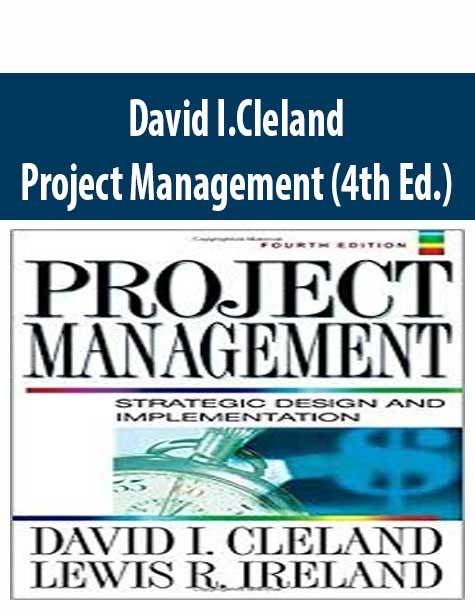David I.Cleland – Project Management (4th Ed.)
$8.00
David I.Cleland – Project Management (4th Ed.)
Product Delivery: You will receive a download link via your order email
Should you have any question, do not hesitate to contact us: [email protected]
DAVID I.CLELAND – PROJECT MANAGEMENT (4TH ED.)
This is the first book to truly apply the theory, processes, practices, and techniques of project management to strategic planning. New to this edition are: risk management, earned value, project recovery, project maturity models, partnering, PM certification, and much more.
“There is nothing permanent except change,” advised Heraclitus of Greece in 513 B.C. Project Management: Strategic Design and Implementation, Fourth Edition, by David I. Cleland and Lewis R. Ireland, provides contemporary evidence that both change and improvement are the natural order of things in project management literature. This new edition contains much of the content of the previous and a whole new look and feel. Its design follows the format of the authors’ previous collaborative success, Project Manager’s Portable Handbook, with decimally numbered paragraphs for structure and bullet lists for detail. This form of layout and presentation results in content that is modularly organized and easily accessible for readers. The authors have improved individual chapters by adding a brief introduction that outlines the central points of the chapter and warms up readers for what follows. Each chapter now concludes with four additional sections: a listing of additional sources of information in the form of a generously annotated bibliography; a listing of project management principles that summarize chapter content in pithy statements of enduring, universal value; a project management situation–a brief, descriptive case study that illuminates chapter content by way of a practical example; and a student/reader assignment that offers food for thought, discussion, or investigation. In whole, the book comprises 22 chapters divided into seven parts that march progressively forward from history through current practice to a view of the future. This new edition provides a guiding graphic that appears at the head of each chapter as a structural map showing readers where they are and maintaining a sense of global reference throughout their journey through the text. In a very general way, the content of this edition follows closely that of the previous edition, as most sequential editions do. This this is no mere tweaking of text to generate a more current publication date and perhaps rejuvenate sagging sales. It is a significant improvement in both form — described above — and substance. The authors have rearranged technical material in places to make it more logical and readable and updated references throughout to make them more relevant to readers and reflective of recent research. The chapter on strategic issues in project management is a good example. The old material is still there, but newly designed with headings, bullets, and graphics that are more appealing in appearance and more facilitating in function. Bringing things up to date, the authors have added a timely discussion of project portfolio management and references to 10 articles as recent as June 2001. Cleland and Ireland have combined previous separate chapters on project organization charting and authority into a single chapter that presents a complete integrated view of these interrelated topics. They also have recast the previous chapter on working with project teams as a discussion of effective project teamwork that is more action oriented and that prescribes specific steps to take when building project teams. A new and much needed chapter addresses project management maturity. The authors briefly discuss the history of maturity models, specific models developed by the Software Engineering Institute and by the Federal Aviation Administration, and two general approaches to model development. They provide a tool for assessing project management maturity and describe the contributing roles of benchmarking and business intelligence. While no cookbook solution to maturity management currently exists, the information in this chapter leaves readers well informed and well armed to deal with this important emerging issue on their own as individual project needs demand. Another welcome addition is a separate chapter on earned value management systems (EVMS). Unlike texts that limit discussion of earned value to syntax and formulas, Cleland and Ireland address concepts, meaning, and application concisely and completely. They temper the unique and essential utility of EVMS with the candid and practical observation that it is not a tool for all projects. It requires a rigorous detailed plan and disciplined management processes. A poorly defined project will condemn an EVMS effort to frustration and failure. Project Management: Strategic Design and Implementation, Fourth Edition, is not the last word on project management theory and practice. Given the evolutionary nature of the domain, such a book probably will never be written. But it significantly raises the bar for books of its kind and sets a standard against which others may be measured now and in the future. Project Management Journal
David I.Cleland, Project Management (4th Ed.), Download Project Management (4th Ed.), Free Project Management (4th Ed.), Project Management (4th Ed.) Torrent, Project Management (4th Ed.) Review, Project Management (4th Ed.) Groupbuy.
Delivery Method
– After your purchase, you’ll see a View your orders link which goes to the Downloads page. Here, you can download all the files associated with your order.
– Downloads are available once your payment is confirmed, we’ll also send you a download notification email separate from any transaction notification emails you receive from IMC.sale.
– Since it is a digital copy, our suggestion is to download and save it to your hard drive. In case the link is broken for any reason, please contact us and we will resend the new download link.
– If you cannot find the download link, please don’t worry about that. We will update and notify you as soon as possible at 8:00 AM – 8:00 PM (UTC+8).
Thank You For Shopping With Us!





6 reviews for David I.Cleland – Project Management (4th Ed.)
There are no reviews yet.